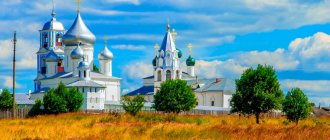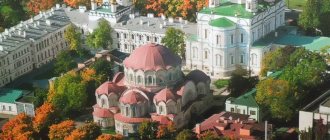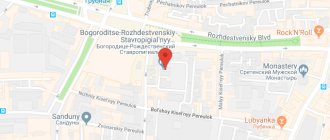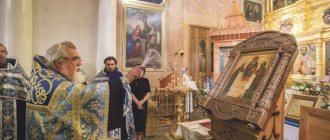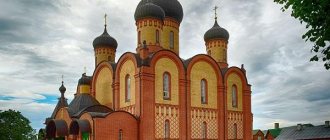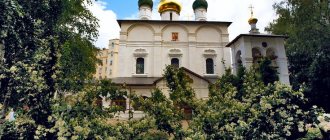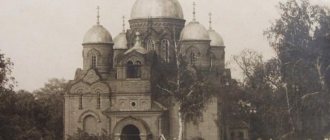Mir
Russia Yaroslavl region Pereslavl-Zalessky Goritsky Assumption Monastery Map loading in progress...
{"format":"leaflet","minzoom":false,"maxzoom":false,"limit":50,"offset":0,"link":"all","sort":[""], "order":[],"headers":"show","mainlabel":"","intro":"","outro":"","searchlabel":"\u2026 \u0441\u043b\u0435\ u0434\u0443\u044e\u0449\u0438\u0435 \u0440\u0435\u0437\u0443\u043b\u044c\u0442\u0430\u0442\u044b","default":"","import-annotation":false,"width ":"auto","height":"350px","centre":{"text":"","title":"""link":"""lat":56.7214910000000003265085979364812374114990234375,"lon": 38.82489000000000345380612998269498348236083984375,"icon":""},"title":"","label":"","icon":"","lines":[],"polygons":[],"circles":[ ],"rectangles":[],"copycoords":false,"static":false,"zoom":8,"defzoom":14,"layers":["OpenStreetMap"],"image layers":[] ,"overlays":[],"resizable":false,"fullscreen":true,"scrollwheelzoom":true,"cluster":false,"clustermaxzoom":9,"clusterzoomonclick":true,"clustermaxradius":80, "clusterspiderfy":true,"geojson":"","clicktarget":"","showtitle":true,"hidenamespace":false,"template":"","userparam":"","activeicon": "","pagelabel":false,"ajaxcoordproperty":"","ajaxquery":"","locations":[{"text":"\u003Cb\u003E\u003Ca href=\"/palomnik/%D0% 93%D0%BE%D1%80%D0%B8%D1%86%D0%BA%D0%B8%D0%B9_%D0%A3%D1%81%D0%BF%D0%B5%D0%BD% D1%81%D0%BA%D0%B8%D0%B9_%D0%BC%D1%83%D0%B6%D1%81%D0%BA%D0%BE%D0%B9_%D0%BC%D0% BE%D0%BD%D0%B0%D1%81%D1%82%D1%8B%D1%80%D1%8C\» title=\»\u0413\u043e\u0440\u0438\u0446\u043a\u0438\ u0439 \u0423\u0441\u043f\u0435\u043d\u0441\u043a\u0438\u0439 \u043c\u0443\u0436\u0441\u043a\u043e\u0439 \u043c\u043e\u043d\u 0430\u0441\u0442\u044b\u0440\ u044c\»\u003E\u0413\u043e\u0440\u0438\u0446\u043a\u0438\u0439 \u0423\u0441\u043f\u0435\u043d\u0441\u043a\u0438\u0439 \u043c\ u0443\u0436\u0441\u043a\ u043e\u0439 \u043c\u043e\u043d\u0430\u0441\u0442\u044b\u0440\u044c\u003C/a\u003E\u003C/b\u003E\u003Chr /\u003E\u003Ca href=\"/palomnik/ %D0% A1%D0%B2%D0%BE%D0%B9%D1%81%D1%82%D0%B2%D0%BE:%D0%90%D0%BD%D0%BD%D0%BE%D1%82 %D0%B0%D1%86%D0%B8%D1%8F\" title=\"\u0421\u0432\u043e\u0439\u0441\u0442\u0432\u043e:\u0410\u043d\u043d\u043e\u0442\ u0430\u0446\u0438\u044f\»\u003E\u0410\u043d\u043d\u043e\u0442\u0430\u0446\u0438\u044f\u003C/a\u003E: \u041f\u043e \u0411\u04 3b\u0430\u0433\u043e \u0441\u043b\u043e\u0432\u0435\u043d\u0438\u044e \u0412\u044b\u0441\u043e\u043a\u043e\u043f\u0440\u0435\u043e\u0441\u0432\u 044f\u0449\u0435\u043d\u043d \u0435\u0439\u0448\u0435\u0433\u043e \u041c\u0438\u0442\u0440\u043e\u043f\u043e\u043b\u0438\u0442\u0430 \u042f\u0440\u043e\ u0441\u043b\u0430\u0432\u0441 \u043a\u043e\u0433\u043e \u0438 \u0420\u043e\u0441\u0442\u043e\u0432\u0441\u043a\u043e\u0433\u043e \u041f\u0430\u043d\u0442 \u0435\u043b\u0435\u0438\u043c \u043e\u043d\u0430 \u0432 \u041f\u0435\u0440\u0435\u0441\u043b\u0430\u0432\u043b\u0435-\u0417\u0430\u043b\u0435\u0441\u0441 \u043a\u043e\u043c \u0432\ u0435\u0434\u0451\u0442\u0441\u044f \u0432\u043e\u0441\u0441\u0442\u0430\u043d\u043e\u0432\u043b\u0435\u043d\u0438\u0435 \u0 41c\u043e\u043d\u0430\u0441\ u0442\u044b\u0440\u044f \u0441 \u043c\u043d\u043e\u0433\u043e\u0432\u0435\u043a\u043e\u0432\u043e\u0439 \u0438\u0441\u0442\u 043e\u0440\u0438\u0435\u0439. \u041f\u043e\u043c\u043d\u0435\u043d\u0438\u044e\u0441\u043f\u0435\u0446\u0438\u0430\u043b\u0438\u0441\u0442\u043e\u0432 \u043e\u043d \u0441\u0443\ XIV \u0432 \u0432\u043e\u0432\u0430\u043b 2\u0435\u043a\u0430","title ":"\u0413\u043e\u0440\u0438\u0446\u043a\u0438\u0439 \u0423\u0441\u043f\u0435\u043d\u0441\u043a\u0438\u0439 \u043c\u0443\u04 36\u0441\u043a\u043e\ u0439 \u043c\u043e\u043d\u0430\u0441\u0442\u044b\u0440\u044c","link":"","lat":56.7214910000000003265085979364812374114990234375,"lon" :38.82489000000000345380612998269498348236083984375,"icon":""}]" imageLayers":[]}
56.721491; 38.82489
Russia, Yaroslavl region, Pereslavl-Zalessky, Museum lane, 4
Pereslavl-Zalessky, Yaroslavl region 152021
Russia
Phones:
;
Dormition Goritsky Convent
- an Orthodox monastery in the city of Pereslavl-Zalessky, abolished in 1744. On the territory of the monastery there is the Pereslavl-Zalessky State Historical, Architectural and Art Museum-Reserve. Currently, the Pereslavl-Zalessky Historical Architectural and Art Museum-Reserve and the Goritsky Bishop's Monastery Compound are working together to transfer the churches to the monastery.
History of the creation of the Goritsky Monastery
The exact date of construction of the monastery is unknown. This is due to a fire that destroyed his entire archive. It happened in 1722 on June 12. According to archaeologists, the Assumption Monastery was founded in 1362 (early 14th century). This is the period of the reign of Ivan Kalita.
There is an opinion that the monastery appeared much earlier (12th century). It arose on the site of the Clown Grove - a former pagan temple. The work of the Moscow Patriarch Joasaph I, “The Ladder of Power,” written by him in 1636, has been preserved. It confirms its existence.
The monastery complex got its name from the word “goritsa”. This is what the locals called any mountain. It was on the hill on the southern side of the shore of Lake Pleshcheev that the monastery was erected.
Perslavl-Zalessky (Goritsky Assumption Monastery was burned by Tatar hordes in 1382) was ravaged by the Golden Horde of Khan Tokhtamysh. All wooden buildings of the monastery were destroyed. Soon the complex was rebuilt. In gratitude for her miraculous salvation, the wife of Grand Duke Dmitry Donskoy, Evdokia, restored the monastery at her own expense in 1392.
There is a legend. Shortly before the Tatar attack, the princess arrived at the monastery. She managed to escape from her enemies along with several associates. On the raft they reached the middle of the lake. Suddenly a fog appeared, hiding them with its veil.
Since then, a unique tradition has appeared in the town of Pereslavl. Every year, Orthodox believers perform an unusual Procession of the Cross, which takes place on the sixth Sunday after Easter. They go from the Goritsky monastery to the mouth of the Trubezh River. From there they sail along the water surface in boats to the center of Lake Pleshcheevo. Thus, they pay tribute to distant historical events.
The Monk Daniel of Pereslavl took monastic orders at the Assumption Monastery, later becoming abbot here. He lived in the Goritsky monastery (from 1470 to 1500). He founded the Holy Trinity Monastery of St. Danilov (1508), which he headed. Canonized as a saint after his death.
Dmitry Prilutsky, who was an associate of St. Sergius of Radonezh, took monastic vows at the Goritsky Monastery (1371). He founded the St. Nicholas Monastery, where he became abbot. The monastery reached its peak in the 16th – 17th centuries. Evidence of this is the stone buildings, which speak of the wealth and high status of the complex.
Then the monastery owned a huge amount of land, villages where more than 5,000 peasants lived. Kings and their families visited the holy place, leaving rich gifts.
Dormition Goritsky Cathedral
From the Church of the Epiphany we went to the Cathedral of the Assumption of the Blessed Virgin Mary - the main building of the Goritsky Monastery. It is known that the Assumption Church was built in the 1750s on the site of an ancient temple, which was erected in 1520.
Until 1838, this particular temple was the main church of Pereslavl Zalessky. The cathedral, like the bell tower, is open only in the warm season, and this is done in order to preserve the paintings on the walls.
Opposite the cathedral you can see a large number of tombstones.
On the plates there are mostly death dates dating back to the first half of the 19th century, but there are also “younger” ones. For example, the artist Dmitry Nikolaevich Kardovsky, who was originally from these places, is buried here.
You can see a massive bell in a niche near the western wall of the Assumption Cathedral, but it has no explanatory signs.
Closure and abolition
Significant changes in the life of the Goritsky complex occurred in 1744. It was closed and the Pereslavl diocese was formed (600 monasteries and 20 churches came under its control).
These are the monasteries and churches of the nearest cities:
- Alexandrov;
- Mozhaisk;
- Dmitrov;
- Volokolamsk
And the Goritsky monastery became a cathedral. The bishop's residence was located here. It was at this time that the construction of the Assumption Church was completed. Active reconstruction of the complex buildings began.
New buildings were erected:
- Bell tower;
- Church of All Saints;
- belfry;
- travel gates;
- St. Nicholas Gate Church;
- part of a stone fence with towers.
Construction took more than 40 years, but was never completed. The Goritsky Assumption Monastery was abolished in 1788. Construction work stopped. The buildings and churches were empty. Several bells were transported to St. Petersburg, and the sacristy to Moscow. However, the authorities of Prereslavl-Zaslessky decided to preserve the architectural ensemble.
The city administration began to use the buildings for various needs. The treasury, the district court, and the magistrate were located here in turn. With the beginning of the work of the city administration, the Assumption Cathedral lost its significance. Now services were held there in the summer during church holidays.
Gradually the empty premises fell into disrepair and were destroyed. However, in 1881 the diocese decided to organize a religious school on the territory of the former monastery. We built buildings and repaired the ancient Cathedral of All Saints. The educational institution operated until 1918.
After the revolution of 1917, the monastery complex became the property of the state. Later, in 1919, a local history museum was opened on its territory. It was led by the famous researcher-historian Mikhail Ivanovich Smirnov.
Later it became known as the state historical, architectural and art museum-reserve, which is still active today.
History[[edit]h2>
The monastery was probably founded at the beginning of the 14th century under Ivan Kalita.
In the Middle Ages, the monastery owned numerous villages, including Bolshiye Sokolniki, Veslevo, Veskovo, Voskresenskoye, Dubnevo, Ermovo, Ilyinskoye, Kruzhkovo, Maurino, Nila, Pertsevo, Rodiontsevo, Slavitino, Solomidino, Chashnitsy, Chentsy, Chernitskoye on Oselke, Chernitskoye on Shah, Yaropoltsy and others (for more details, see here).
On June 12, 1722, the monastery archive was destroyed in a fire.
Unfortunately, historical information about this monastery is very brief, fragmentary and unclear, since the archive of the monastery has not been preserved, and all information about it is obtained from various secondary sources. Here is the information that is available about the monastery: the founding of the Dormition Goritsky Bogoroditsky Monastery dates back to 1362. It is erroneously believed that the Monk Dmitry Prilutsky took monastic vows at the Goritsky Monastery. But this couldn’t happen, because... by the time the monastery was founded, he was already the abbot of the Nikolsky Monastery he founded in the same Pereslavl.
In the 15th century, Saint Daniel lived there and was abbot (from 1470 to 1500), who founded the Trinity Danilov Monastery right there in Pereslavl (in 1508), where he moved from the Goritsky Monastery. The further fate of the latter in the 16th and 17th centuries is unknown. In 1744 it was abolished and given over to house the bishop's house of the newly established Pereslavl diocese, which was abolished in 1788.
During the stay of the bishops there, the following buildings are known: the Cathedral of the Assumption of the Blessed Virgin Mary and Gethsemane, between 1753-1761; bell tower with the Church of the Epiphany 1768-1777; at the same time (instead of the ancient ones) part of the fence and tower was built again; these later parts start from the bell tower, then go along the north side and partly along the west; their architecture is clearly different from the ancient ones, as can be seen in nature.
In 1744, the Pereslavl Dormition Goritsky Monastery was closed and turned into the estate of the Pereslavl bishop. Contemporaries well understood this state of the former monastery. In 1802, Pereslavl official Pyotr Plishkin writes that “It was called the Goritsky Monastery until 1744, that is, before the establishment of the Pereslavl diocese.”
In 1788, the Pereslavl diocese was closed and the bishop's house was abolished.
In the “Description of Monasteries Located in the Russian Empire” (1817), “Goritsky Uspensky, destroyed, near the city of Pereslavl-Zalessky” is mentioned. And twenty years later, this monastery was no longer in the book (1834 edition).
In 1904, the inside of the monastery presented a sad picture of desolation: a huge space, surrounded by walls, is a wasteland overgrown with grass, with piles of garbage and an overgrown pond; on one side there are two churches and several insignificant new buildings, lost among the huge wasteland; the fence, gates and towers are dilapidated and dilapidated.
The oldest buildings of the monastery, which undoubtedly existed in the 17th century, remain only two gates, of which one is “Saints”; a southern fence with one tower and, one might add, the Church of All Saints (which has almost lost its ancient appearance due to later additions). The “Holy Gate” with the Church of St. Nicholas represents one of the outstanding examples of ancient Russian architecture and therefore was repeatedly depicted and described in various publications; Of these, the most valuable are the drawings included in the publication by F. Richter, where you can see all the details of the processing. The year of construction of the “Gate” is unknown, but is indicated by many researchers in the period of the 17th century.
After the revolution in 1919, the Pereslavl Museum-Reserve was transferred to the monastery.
Monastery architecture
The architecture of the monastery is distinguished by many small details, executed with extreme precision.
Travel gates
The travel gate is an example of Russian architecture (mid-2nd half of the 17th century). They are located in the eastern part of the complex fence.
The outer wall of the gate is framed by carved, massive arches and richly decorated with various architectural elements and sculptural figures. 2 low round columns are located on both sides of the portal below. Above each pair of pillars (in a niche) a galloping horse is sculpted.
Gatekeeper's Chamber
A small building is located to the left of the entrance to the eastern (travel) gate. In ancient documents it is called the gatekeeper's chamber.
The 2 external facades of the building are decorated very richly and magnificently, like princely or bishop's houses. The platbands have complex patterns, the walls are decorated with repeating balusters, curbs, and small semi-columns.
Refectory Chamber
Based on the western façade of the building, they determined what it looked like before. When the wall was cleared of a thick layer of old plaster, underneath it were the outlines of ancient frames that once framed the windows.
Inside the building there are unusual vaults of various shapes, as well as very interesting formwork located above the door and window openings. The refectory room located on the second floor looks impressive. In its center there is an octagonal pillar. It supports high ceilings.
Belfry
The belfry was built in the 19th century (second half). The building itself is small; it visually divides the northern fence of the monastery into two halves. Today it is used as an observation deck.
From the second tier, visitors can see the ancient city and lake.
Monastery churches and buildings
The Cathedral of the Assumption of the Blessed Virgin Mary was built between 1753 – 1861. It was designed by the architect Ivan Yakovlevich Yakovlev. The massive quadrangular structure is surrounded by covered galleries with wide arched windows. The building is crowned with 5 small domes.
Map of the Goritsky Assumption Monastery in Pereslavl-Zalessky
In the eastern part of the building, a semicircular protrusion (apse) covered with a semi-dome is attached to it. On each side rises a tower-shaped, octagonal aisle, ending with a small dome, which is equipped with light drums and dormers (lucarnes).
A large bell weighing 149 pounds 19 pounds stands in a niche in the western wall. It was cast especially for the city of Pereslavl-Zalessky at the plant of Pavel Nikolaevich Finlyandsky in 1865.
From the outside the building is quite modest. Inside, the interior of the cathedral has luxurious decoration - Baroque panels, lush stucco moldings, and picturesque frescoes. The beauty was created by the best architects of the New Jerusalem Monastery. The majestic, multi-tiered, carved iconostasis is considered an indisputable work of art. It was made by a famous master from Moscow - Yakov Zhukov.
It is covered with gilding, decorated with all kinds of figured sculptures, floral ornaments, and baroque columns. Painters from New Jerusalem painted icons. The temple is open during the warm season. The three-story Gethsemane was built next to the cathedral. It would connect him and the Church of All Saints. All that remained was to make the roof.
But the plans did not come true, the monastery was closed, construction stopped. Subsequently, the Gethsemane building was dismantled into bricks, and a theological school was built from them. Only the column, which is located in the museum, was preserved.
The tallest building of the monastery is considered to be the small Church of the Epiphany, equipped with a four-tier bell tower. Construction began in 1768 and was completed in 1777.
The small temple itself is located on the first floor. The building is covered by a towering dome with dormer windows. It is crowned with a small dome. There is a platform on the top floor of the bell tower. From there you can clearly see the entire city and Lake Pleshcheyevo.
The Church of All Saints was built in the 2nd half of the 17th century. instead of a stone building from the 16th century. Square three-apse building. The refectory chambers are adjacent to it. It is crowned with five small chapters.
Later it was rebuilt. The building was empty for more than 100 years (1780s - 1880s). Renovated in 1883. It was a house church at a religious school until 1918.
The Holy Gate is considered one of the most ancient buildings of the monastery. They appeared in the 17th century. Their lower tier with a wide arch is luxuriously decorated with figured bricks.
By the end of the same century, the Church of St. Nicholas the Pleasant was built over the gate. The square building is covered with a hipped roof. On top of it, on top of each other, there are two decreasing octahedrons crowned with a small dome. There are galleries on the sides of the temple
The entire ensemble is a harmonious combination of Moscow baroque and patterned style. The temple is operational, transferred to the Russian Orthodox Church. It contains a shrine - the shoe of St. Spyridon of Trimifuntsky.
The gift of His Holiness the Patriarch of Constantinople was brought by Mother Euphrosyne from the Greek city of Kerkyra, on the island of Corfu. There are also icons that stream myrrh. The stone fence of the monastery was completed in the 18th century. It is low, decorated with loopholes. The towers standing along the walls facing the north side are very skillfully made. The function of the fence is decorative.
In the 19th century, the Theological School buildings were added to the refectory chambers of the All Saints Church. The teachers' apartments were also located there. The building now houses an art gallery.
The pond was dug on the territory of the monastery in the 18th century. There is a reservoir nearby from which water flows through pipes. Fruit trees planted by museum employees along the banks in 1925 grow.
The one-domed chapel named after St. George the Victorious was brought from the village of Foninskoye in the 1980s. Another chapel of the same type (in honor of the Intercession), decorated with five domes, was delivered from the village of Starovo in 1983. A museum ticket office was located inside it. Both buildings are wooden and date back to the 19th century.
In 1963, the museum was given a bust of Yuri Dolgoruky, the founder of the city of Pereslavl-Zalessky. It was made by sculptor S.M. Orlov. He repeated the Moscow monument that stands on Tverskaya Square.
Holy Gate and Church of St. Nicholas the Wonderworker
The Holy Gate is considered one of the most ancient buildings of the monastery. The exact date of their construction is unknown, but scientists are inclined to assume that they appeared already in the 17th century. The Church of St. Nicholas the Wonderworker above the Holy Gate was built later, at the end of the 17th century. After the abolition of the Pereslavl diocese, no services were held in the church, but now one of the museum’s exhibitions is located there.
Opposite the passage gate through which you enter the territory of the Goritsky Monastery, you can see a small wooden chapel. She was brought to Pereslavl in 1983 from the nearby village of Starovo. Now here is the ticket office of the museum-reserve; tickets to all exhibitions are purchased here, as well as tickets to the bell tower.
It is from the bell tower that we will begin our acquaintance with the architectural monuments of the Goritsky Monastery.
Goritsky Museum-Reserve
Today the monastery is a museum complex. Its arsenal contains more than 90,000 exhibits. Many of them are unique. Entire collections of ancient icons, paintings, wooden sculptures, and silver items are collected here.
There are works by goldsmiths and goldsmiths, exhibits of the “amusing flotilla” of Peter I. Memorial halls dedicated to the artist D.N. Cordoba, opera and chamber singer F.I. Chaliapin. There are paintings by I.I. Shishkina, V.D. Polenova, I.M. Pryanishnikov, A.N. Benois, K.A. Korovin and many other painters. There is an extensive library.
Pereslavl-Zalessky (the Goritsky Assumption Monastery was transferred to the diocese of the Russian Orthodox Church by decision of the government of the Yaroslavl region in 2012) acquired another spiritual center. The museum-reserve, together with the bishop's courtyard, is working on the transfer of the complex.
Rules for visiting monasteries
Now the territory of the monastery is a museum. Services are constantly held only in St. Nicholas Church. Clothing must comply with church rules.
Women should wear long dresses and skirts (length below the knees). The upper part of the outfit has long or ¾ sleeves. A headscarf, scarf, scarf, or hat are put on the head. Men must wear shirts, T-shirts, and trousers. T-shirts and shorts are not acceptable.
Monastery opening hours
According to an agreement with the museum, the gate temple of St. Nicholas the Pleasant is open for worship: from 8.00 - 10.00 on Saturday - Sunday. All details can be clarified with Mother Euphrosyne. Phone 8(916)437 15 30,.
Museum schedule:
| Period | Opening hours |
| May – September | 10.00 – 18.00 |
| October – April | 10.00 – 17.00 |
| Day off | Monday |
| Sanitary day | Last Tuesday of the month |
Useful information for tourists
Pereslavl-Zalessky (the Goritsky Assumption Monastery does not yet operate as a religious complex) is famous for its monasteries, four of which are active. The museum hosts excursions and exhibitions. Inspection of stone buildings is available.
The temples of the museum are closed during the winter so that the cold air does not damage the interior decoration of the cathedrals. You can visit them from May to September.
It is allowed to film and photograph temples, buildings, attractions, and museum exhibitions outside and inside buildings. Flash cannot be used. If a tripod and additional lighting are used, then this is commercial photography. It is carried out with the consent of the museum administration under an agreement. Phone 3-19-10, 2-34-68.
Church of the Epiphany with bell tower
The Church of the Epiphany is located on the lower floor of a four-tier bell tower, built in 1768-1777. After the abolition of the Pereslavl diocese, the bell was dismantled from here and sent to St. Petersburg to the Peter and Paul Fortress. Nowadays, the methodological department of the museum is located here, and at the very top there is an observation deck, which offers stunning views of Pereslavl-Zalessky and Lake Pleshcheyevo .
The ascent to the top is carried out first along stone and then along wooden stairs. All the ceilings between the tiers look completely new, it seems that quite recently the bell tower of the Church of the Epiphany was renovated.
On one of the levels, the windows are covered with plywood sheets, on which many tourists for some reason leave their autographs. There are many entries from 2005-2006; apparently, the bell tower was renovated about ten years ago.
From the height you have a truly magnificent view of the city. The entrance here is paid, and we did not notice a crowd of people, as is usually the case at observation platforms, but I must say that people are missing out on a lot - the views are very beautiful.
To be fair, it is worth noting that it is worth climbing the bell tower in order to see what the Goritsky Monastery looks like from above, because other views can be enjoyed from the fortress walls, and you do not need to pay for it. By the way, you can get into the bell tower only in the warm season; in winter it is closed for inspection.
How to get to the monastery
There are regular buses from Moscow to Pereslavl-Zalessky: “Moscow – Pereslavl-Zalessky”, “Moscow – Yaroslavl”, “Moscow – Kostroma” and others. This is the only direct connection (distance – 144 km).
Departure daily from the bus station to VDNKh, from morning to evening. The duration of the trip is 2 – 3 hours. In the city (from the bus station) you can get to the monastery on foot in 20 minutes, take bus No. 1 (Museum stop) or take a taxi.
By car, the main route from the capital is along the M8 Moscow – Yaroslavl highway. From the Moscow Ring Road you need to drive 110 kilometers to the traffic police post. Behind it on the left there will be a road that leads to Pereslavl-Zalessky.
There is no train station in Pereslavl. They get there from the nearest stations in the village of Ryazantsevo (22 km) and the village. Berendeevo (20 km) via Alexandrov by bus or taxi. A more acceptable route: Moscow railway station - Sergiev Posad (train takes 1 hour 30 minutes). Then they go by bus to Pereslavl (70 km, 40 – 60 minutes).
Second Goritsky Monastery
On the banks of the beautiful Shekspa River in the village of Goritsy, Kirillovsky district, Vologda region, the Resurrection Goritsky convent is located. The monastery was founded by Efrosinya Andreevna in 1544, the widow of Prince A.I. Staritsky (the uncle of Tsar Ivan the Terrible).
Later she was forcibly sent to the monastery, giving the name Evdokia (1563). The princess was killed in 1569. Euphrosyne's body was buried on the territory of the monastery. Later he was canonized. For many years the Resurrection Monastery was a place of exile. Women from noble families lived in captivity here.
Among them:
- wife of John IV - Anna Koltovskaya;
- mother of Tsarevich Dmitry - Maria Nagaya;
- daughter of Boris Godunov - Ksenia;
- an unknown girl of the noble class (history researchers suggest that she was the failed wife of Peter II - Ekaterina Dolgorukova);
- Alexander Menshikov and his entire family were sent here.
The Church of the Resurrection was erected in 1544 instead of a wooden church. This is a two-story building. It was built with the money of Prince Staritsky. Above the temple. Nun Martha built a square bell tower in 1611.
The bell tower was thoroughly rebuilt in the 18th century. Today the church is not working, it needs to be restored. The warm Cathedral of the Holy Trinity, equipped with three altars, was built during the time of the abbess of Mauritius Khodneva in 1821. During the period of Soviet power, the House of Culture was located here. He was taken outside the monastery after the monastery was restored.
The Intercession Church on two floors was built in 1832. Funds were provided by Princess Khovanskaya (in the schema of Paraskeva). The building is warm, it is located in the eastern part of the complex.
There was a home for the disabled here during the Soviet period. Later - the administration of the state farm. The ancient building was restored. Now it has been the main temple of the complex since 2003. The territory of the monastery is enclosed by a stone wall. There is a tower at each of the four corners. Within the walls of the fence are living quarters, hotel rooms, and hospital wards.
There are three exits from the monastery in different directions of the complex. The Holy Gate goes towards the bank of the Shakspa River. The monastery has its own water supply. It appeared during the reign of the mother of Mauritius. A spring was dug outside the walls of the monastery. Pipes were laid to the stone chapel specially built for these purposes, and to all other buildings of the complex. The water supply still works today.
Inside the complex there is a stone one-story building. It is adjacent to the Church of the Resurrection. It contained a kitchen and a refectory. Several wooden buildings were also erected (late 19th – early 20th centuries). They contained living quarters and workshops.
The Church of the Presentation was built near Shekspa in the western part of the monastery. There was a cemetery next to it. The temple operated until 1937. Then a garage was located there. Restoration work began in the 1990s. Services resumed in 1999. The building was handed over to the nuns in 2000.
Outside the walls of the complex, the chapel of John the Baptist was built, a pier in 1905. Wooden buildings for household needs were also located there.
Address: index 161107, Goritsy village, Kirillovsky district, Vologda region.
Telephone: 7(81757)5-81-30.
The Goritsky Assumption Monastery of the city of Pereslavl-Zalessky and the Resurrection Monastery are monuments of architecture and the Orthodox religion of federal significance. Every year they are visited by a large number of believers, tourists, and history buffs.
Author: Tatyana B.
Article design: Mila Friedan
Pereslavl-Zalessky. Goritsky Monastery, Gramophone Museum, Peter's Boat and Sin-Stone
Tatyana Afanasyeva
We decided to visit Pereslavl-Zalessky after Olya Melnikova’s gulbaria. It seemed that this was some absolutely fabulous town on the shore of a huge blue lake, where there were a lot of different attractions and they sold amazingly delicious fish. And in general, our expectations were met. Olya, thank you ♥ I’ll try not to repeat myself, catch a new story about Pereslavl
And in general, our expectations were met. Olya, thank you ♥ I’ll try not to repeat myself, catch a new story about Pereslavl
Our weekend route united two cities at once - Rostov the Great (there was already a Gulbari) and Pereslavl-Zalessky. There are only 67 kilometers between them, both are part of the “Golden Ring of Russia”, stand on the lake (Rostov - on Nero, Pereslavl - on Pleshcheevo) and pump out money from tourists to the maximum! I guess I have never seen such cities where you literally pay for every step you take. Even monasteries are no exception.
There are only 67 kilometers between them, both are part of the “Golden Ring of Russia”, stand on the lake (Rostov - on Nero, Pereslavl - on Pleshcheevo) and pump out money from tourists to the maximum! I guess I have never seen such cities where you literally pay for every step you take. Even monasteries are no exception. And in Pereslavl there are six of them! Goritsky, Nikitsky, Nikolsky, Sretensky Novodevichy, Holy Trinity Danilov and Feodorovsky. They are located very closely; if you really want to, you can become a monk
And in Pereslavl there are six of them! Goritsky, Nikitsky, Nikolsky, Sretensky Novodevichy, Holy Trinity Danilov and Feodorovsky. They are located very closely; if you really want to, you can become a monk
The Dormition Goritsky Monastery (XIV century) seemed to us the most interesting and original True, since 1774 it has not been a monastery at all. First a bishop's estate, and later a museum-reserve. But this does not spoil it - a quiet and ancient monastery on a high hill (goritsa), surrounded by a white stone wall with turrets, overlooking Pereslavl and Lake Pleshcheyevo, a large internal garden and a nice atmosphere. Admission is paid - 50 rubles per person. Address: Museum Lane, 4.
Source of top view ecozemlya.ru.
On the territory of the monastery there is a monument to Prince Yuri Dolgoruky, the founder of Pereslavl-Zalessky. It was by his decree that a new fortress city grew in 1152 on a swampy plain surrounded by forests. The prince had big plans for Pereslavl - he wanted to see it as the future capital of North-Eastern Rus'.
Behind Dolgoruky’s mighty back they discovered a “fire-fighting pond” and a house for a duck . It is not known with whose money and by whose decree it was built.
. It is not known with whose money and by whose decree it was built.
I really love monasteries with the opportunity to walk along the wall and look down on the parishioners 
By the way, in 1744-1788 the Goritsky Monastery was the center of a huge diocese, which included Mozhaisk, Volokolamsk, Dmitrov and Alexandrov. During the heyday of the monastery, when the residence of the bishop was within its walls, the luxurious Assumption Cathedral (1750s) - in the Italian Baroque style, rare for Russia. Now the cathedral is not going through its best years.
In general, there are a lot of interesting things on the territory of the monastery. Near the walls of the Assumption Cathedral there is a large bell, weighing 149 pounds 19 pounds, cast at the Finlyandsky factory in 1865.
In the midst of the monastery garden there are two traditional wooden chapels. They were brought from the villages of Starovo and Foninskoye, Pereslavl region.
Such chapels were built in one day by traveling carpenters with money raised by “the whole world.” That's cool!
In the chapel on the right, we discovered a statue of Christ, which Gaidai filmed in his brilliant comedy “Ivan Vasilyevich Changes Profession” 
In the monastery, of course, there are ancient burials. One of the tombstone sculptures is a real work of art. This is a mourner with a giant pepper shaker and a snake. The snake is most likely a reminder of the words of Christ: “The Son of Man can ascend into heaven, just as Moses lifted up the snake in the desert.” But not a fact. If you know more, please share.
In the Gate Church (visiting is free), I was surprised by several details: a clock with Cyrillic alphabet, an icon of “The Merciful with the Breadwinner” (alas, there are no photographs, but the icon is interesting) and a huge calendar with guardian angels for every day of the week on the entire wall.
“tire demon” was spotted from the walls of the monastery . He stands next to the Radio Museum (40 Podgornaya St.) and seems to sing in Kipelov’s voice: “I’m free!” Ooooh, watch out, tire swans, this one (!) will tear anyone to shreds :)))
As soon as we had a view of Lake Pleshcheyevo, I fell in love with it. Endless blue surface. Really impressive!
And then a boat with fishermen moored to the shore. One brought out a fish tank full of some small fish and said tragically: “Well, at least this way...” :))) At that moment, somewhere in parallel worlds, a howl was heard from Tula fishermen sitting on the bank of the Upa River opposite the machine plant.
Lake Pleshcheyevo is famous for its fish with a cute name - vendace. There is no such thing anywhere in Russia, only here! Pereslavl vendace is included in the Red Book and in order to catch it, you must have not only the desire, but also a special permit. Smoked vendace is even depicted on the official coat of arms and flag of Pereslavl-Zalessky.
Address of the art object “with the official seal”: st. Kardovsky, 22.
In the 15th century, Pereslavl vendace was supplied to the royal table. I don’t know if we really ate this particular magical fish, but we were convinced that yes, it was hers. And it was so good that I could have eaten another small family of 15-20 fish people! By the way, a minute of advertising: fish is sold everywhere in Pereslavl, but I advise you to buy it from the walls of the Nikitsky Monastery and specifically from the guy with the tattoo “For the Airborne Forces...”
Monastery address: st. Zaprudnaya, 20 (Nikitskaya Sloboda).
The assortment is large - catfish, bream, vendace, greenling, pike, saber-toothed sterlet and many other fish, the names of which I simply did not remember. There is both felted and smoked. Everything is given for testing! And this is some kind of fishy love spell, it’s very difficult to leave. When I almost managed to control myself and moved towards the car, the driver asked: “Have you tried the cheese fish?” Cheese! He's a peled. Let's stay :))) You can go to Pereslavl for fish tastings alone.
an information center in Pereslavl where they will give you a bunch of free maps, booklets and tell you about all the festivals that take place on this day in the city and its immediate surroundings. Useful place Center address: st. Proezdnaya, 1. Not far from it are Red Square, the city ramparts, and the Transfiguration Cathedral (it is the same age as the city! It was founded by Yuri Dolgoruky in 1152). And somewhere here, in the princely chambers near the cathedral, Alexander Nevsky was born.
Useful place Center address: st. Proezdnaya, 1. Not far from it are Red Square, the city ramparts, and the Transfiguration Cathedral (it is the same age as the city! It was founded by Yuri Dolgoruky in 1152). And somewhere here, in the princely chambers near the cathedral, Alexander Nevsky was born.
Next we decided to visit the museum-estate “Botik of Peter the Great” (Veskovo, Peter St. 1) . This is, in general, an iconic landmark of Pereslavl and one of the oldest museums in Russia. It was here, on Lake Pleshcheyevo, that Peter the Great built the famous amusing flotilla, which laid the foundation for our navy.
Secretly from his mother, at the beginning of July 1688, the 16-year-old Tsar visited Lake Pleshcheyevo for the first time. It delighted Peter with its size - it’s 50 square meters. kilometers! “Obviously there is a courtyard and courts here.” Well, off we go! Naturally, under the strict guidance of Dutch shipbuilders.
The estate includes the White Palace, the Botny House, the rotunda, the Triumphal Gate and the gatehouse. Entrance to the estate is paid (20 rubles). Entrance to the Botny House is also paid (50 rubles). You can’t get away with Pereslavl people - they value and monetize your every step. I have never seen a more miserable city.
The Botny House opened in 1803 with a loud motto: “To Great Peter - zealous Pereslavl.” The legendary boat “Fortune” and its drawings are stored in this small building. And in general that's all...
By the way, we were in Peter’s house in the Dutch Zaandam , which in the same way preserves the history of the Russian Tsar-shipbuilder and has been located inside a stone “case house” for more than 100 years. So this is simply incomparable! According to impressions and emotions, for me personally.
Opposite the estate there was an interesting museum - the “Museum of Gramophones and Records”. Naturally, ticket prices were steep (this is Pereslavl - the city of the greedy!). Just come in and look - 100 rubles, photos - another 50 rubles, excursion - 600 rubles. I’ll say right away that without a tour this museum will not make the right impression: you simply won’t notice, see, and, most importantly, hear a lot!
Just come in and look - 100 rubles, photos - another 50 rubles, excursion - 600 rubles. I’ll say right away that without a tour this museum will not make the right impression: you simply won’t notice, see, and, most importantly, hear a lot!
And you have a unique chance to listen to records, gramophones and gramophones, born in different countries and at different times. Yes, yes, this is not just an antique salon, it is a museum that sings for guests. A very interesting and cordial place!
Even the progenitor of all gramophones and gramophones is there. Meet the phonograph ! This is the very first device for recording and playing sound. It was invented by Thomas Edison and introduced to the world on November 21, 1877. The phonograph's sound track was placed in a spiral on a replaceable rotating drum coated with foil or wax.
This is the very first device for recording and playing sound. It was invented by Thomas Edison and introduced to the world on November 21, 1877. The phonograph's sound track was placed in a spiral on a replaceable rotating drum coated with foil or wax.
There is only one phonograph in the museum; the rest of the space is occupied by gramophones, gramophones, electrophones, tape recorders and all kinds of accessories for them. There is not just a lot of information, there is a lot of it.
My theory that the gramophone is without a trumpet, and the gramophone is with a trumpet, was shamefully broken in the first 10 minutes. This picture, it turns out, is shamelessly LYING! I wonder how many people thought and think the same? :)))
The owner of the museum finally revealed to us the terrible secret of all Soviet “gramophones”. They're gramophones! :))) And it’s not about the pipe and compactness, but about the needles, the carriers of sound and the way it is reproduced. If in tsarist times no one confused gramophones and gramophones, then during the USSR incredible confusion began. And, of course, it’s all Stalin’s fault :))) Please note that the Molotov plant produced gramophones, but for some reason they had gramophone needles. And on these very “gramophones” gramophone records were played using gramophone needles, which is essentially impossible 
Here are the so-called gramophones from Soviet times. One with a pipe! :))
And here's a gramophone without a pipe :))) Japanese. The Nipponola. If there were a gramophone, it would be impossible to play gramophone records on it.
And we listened to the gramophone! :)))
To be honest, the version with a pipe was much simpler for me, but now I can’t tell at one glance. What is this, a gramophone, a gramophone?.. :)))
The sign says that this is a talking musical device - a gramophone
So how is a gramophone different from a gramophone?
A gramophone is a device for reproducing sound from a gramophone record, patented by Berliner in 1887. Records were originally made from ebonite and shellac, and the world's first gramophone record was generally made of zinc. To make one shellac record, the labor of four thousand varnish bugs was required. The records were single-sided and very expensive. The pointed needle moved along the plate in a spiral, from the edge to the center. The needles quickly ground down and had to be changed every 3-4 minutes. In general, at that time the gramophone was a very expensive pleasure!
In 1907, the Pathé brothers and their company introduced the gramophone. It differed from any gramophone not in its appearance (it didn’t matter whether it was a hidden horn or an external one), but in its sound groove. She was deep. Playback did not proceed from the edge of the record to the center, but, on the contrary, from the center to the edge. The needle did not have a sharp end, but a rounded one - the so-called sapphire needle, which could be reused.
In general, you need to spend more than one hour in this museum to finally understand everything :)))
Decca gramophone, British (note, no trumpet!). We were even allowed to twirl its handle to dance the Charleston. Just 10 turns, and the room with us seemed to have been transported to another time.
We were even allowed to twirl its handle to dance the Charleston. Just 10 turns, and the room with us seemed to have been transported to another time.
And this is a gramophone from India. Unexpectedly, it turned out to be a remake :))
Micphone. As the accompanying plaque says: this is the first, smallest, and probably the most beautiful pocket gramophone in the world, a treasure of Swiss applied art. The shape and size of the mikiphone are deliberately reminiscent of a large Swiss pocket watch. The creators, the Vadas brothers from Hungary, patented the mikiphone in November 1924. The mikiphone was produced by the Swiss company Paillard from 1925 to 1927, including in gold and silver versions for wealthy customers. And again no pipe ;)))
The Belgian gramophone Colibri is so tiny that people went on dates with it, hiding it in their pocket. By the way, it still works, despite its advanced age - it was produced in the 1930s.
German Telefunken. And this happened in the history of the famous company that produced radios for Mercedes-Benz in the post-war years and televisions in our days.
The German gramophone Edelton boasted to us about its suitcase made of genuine crocodile leather 
“Baby” weighing only 2 kilograms was produced by the Moscow Gramophone Plant since 1930 for officers of the Red Army. This one took part in the Great Patriotic War, as they say.
And this is generally a unique exhibit that has no analogues. It was collected from improvised means by prisoners in Kolyma.
In 1935, the first electric player was released in the USSR, called EPPG-1 (electric gramophone record player). It was designed to play standard records at 78 rpm. In the 1950s, electrophones began to confidently replace gramophones. , long-playing records appeared at the same radial speed (78 rpm), due to a decrease in the track pitch, the sound duration of one side of a grand record increased to 7 minutes instead of the usual three. But they were produced for a very short time.
An electric player for truckers :)) It has a movable platform with shock absorption. Miracle technology, one might say. In rural clubs he went with a bang - the floor was shaking, and he plays and sings.
Network tube radiogram "Ural-57". Cute and cozy retro. But the sound is already so-so - in comparison with gramophones and gramophones.
To be honest, as soon as we moved to the part of the museum with electric players and tape recorders, I began to lose interest :)) The same cannot be said about Valery Andreevich - on the contrary, he spun up to 150 rpm.
This definitely deserves attention! Flat video disc, the grandfather of computer CDs :))
And in the background there is a Rigonda player (did you notice it?). Home hit of the 1970-80s :)) Do you know where the name comes from? From the novel “Lost Homeland” by Vilis Latsis, in which there was a fictional and mysterious island of Rigonda. When we were children, we played our favorite records with songs and fairy tales on these “rigonds.” “The Musicians of Bremen”, “The Flying Ship”, “The Swamp King’s Daughter”, “Aladdin’s Magic Lamp”, “The Adventures of Dunno”... Which ones did you have? :)))
Records are a separate and very large topic. I will show only a few that amazed us. Well, first of all, colorful!
...and even in the shape of a heart ♥
Secondly, political  with reports from Stalin, Molotov and their friends.
with reports from Stalin, Molotov and their friends.
Thirdly, recordings on old X-rays - the so-called “music on the ribs”, “rock and roll on the bones”  A phenomenon of musical culture in the 1960s and 70s, when foreign hits could be bought exclusively under the counter or in such self-made "pirated version".
A phenomenon of musical culture in the 1960s and 70s, when foreign hits could be bought exclusively under the counter or in such self-made "pirated version".
Fourthly, audio letters with a photo of the sender.  They had to wait for months, but what a thrill it was to receive them. A bygone era, a lost romance.
They had to wait for months, but what a thrill it was to receive them. A bygone era, a lost romance.
Fifthly, the record “Count L.N. Tolstoy. Thoughts from the book “For Every Day” of the early 20th century. With a real writer's voice! :))) In general, our guide, having learned that we were from Tula, said: “It’s nice when “foreigners” come, that’s how we usually have Muscovites here. And today is a good day - you are from Tula, there were a couple more from Ryazan.”
And one of the count’s thoughts for every day is “Don’t worry about tomorrow, because there is no tomorrow. There is only now; live for it, and if what you have is good today, it will always be good.”
is “Don’t worry about tomorrow, because there is no tomorrow. There is only now; live for it, and if what you have is good today, it will always be good.”
Leaving the Gramophone and Record Museum, I wrote a review with pen and ink, sitting at a real school desk. I think the last time I sat at one of these was when I was in first grade :)))
We visited all the other museums in Pereslavl tangentially and passing through :))) We didn’t have that much time or that much money. And there are apparently and invisibly museums: teapots, irons, antique sewing machines, the history of money, radio, steam locomotives, cunning and ingenuity, fairy tales and forests... In general, there is a good reason to return 
Saying goodbye to Pereslavl we visited Sin-Kamen . The same stone that can crawl, make wishes come true and collect money from visitors (for now 50 rubles each, but this is hardly the limit). Major stories and legends have been told here.
I can’t say that the stone made any special impression on me. But the surrounding area - yes! In Tula, we would definitely love a place like this for picnics - with velvet lawns, fire pits and log cabins as tables and benches. Lake Pleshcheyevo with the Blue Stone, of course, is unlikely to crawl to us :))) but, I remember, our authorities said something about a picnic area in Batashi and in the Levoberezhny area. Maybe everything is already there, but I don’t know? 
Want to share your “travel stories”? Write in a personal message to Tatyana Afanasyeva And long live our common and endless “Gulbari”!
Gallery
show all photos
Survey
You are in Pereslavl-Zalessky. You only have money in your pocket for one museum...
